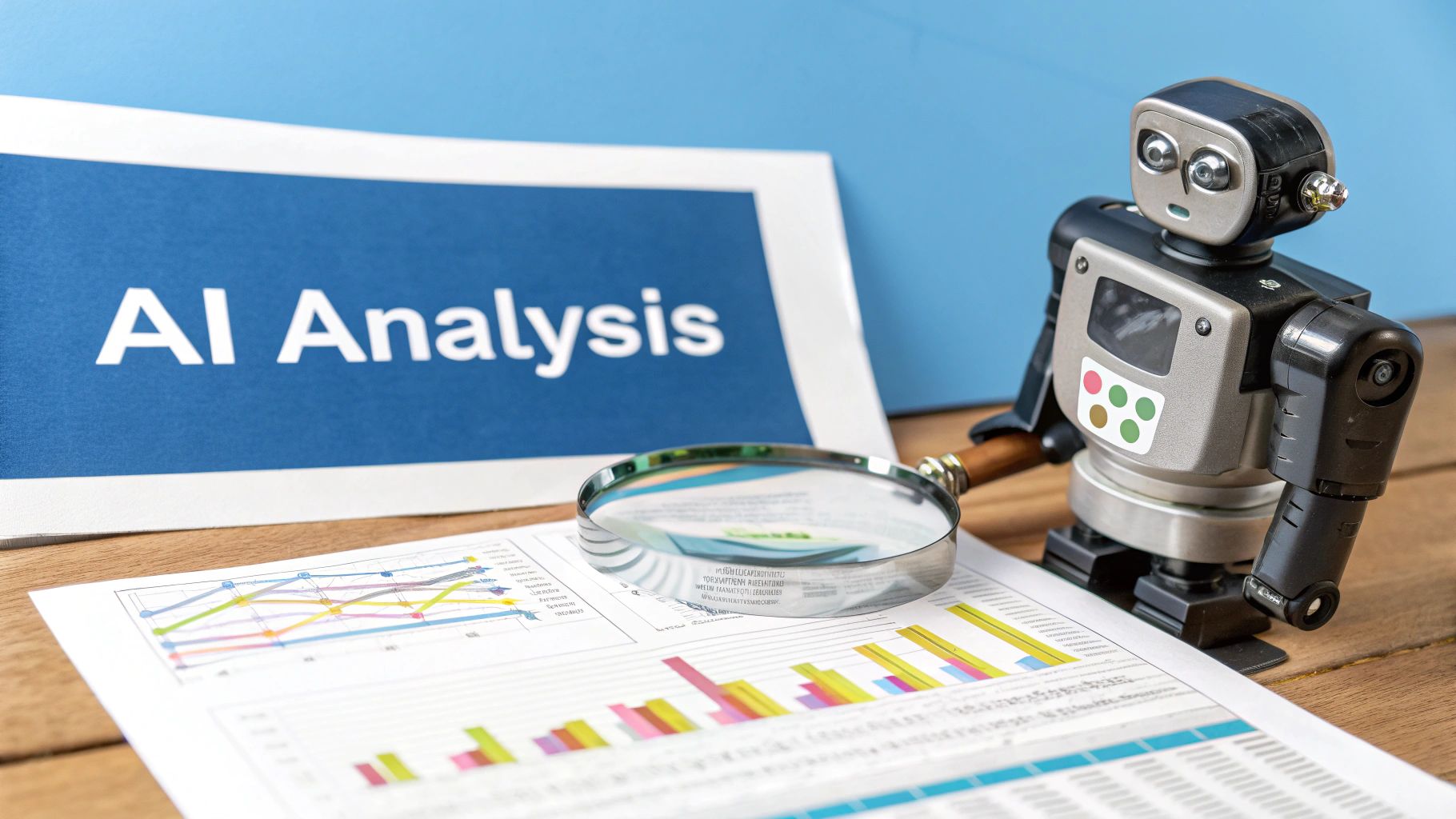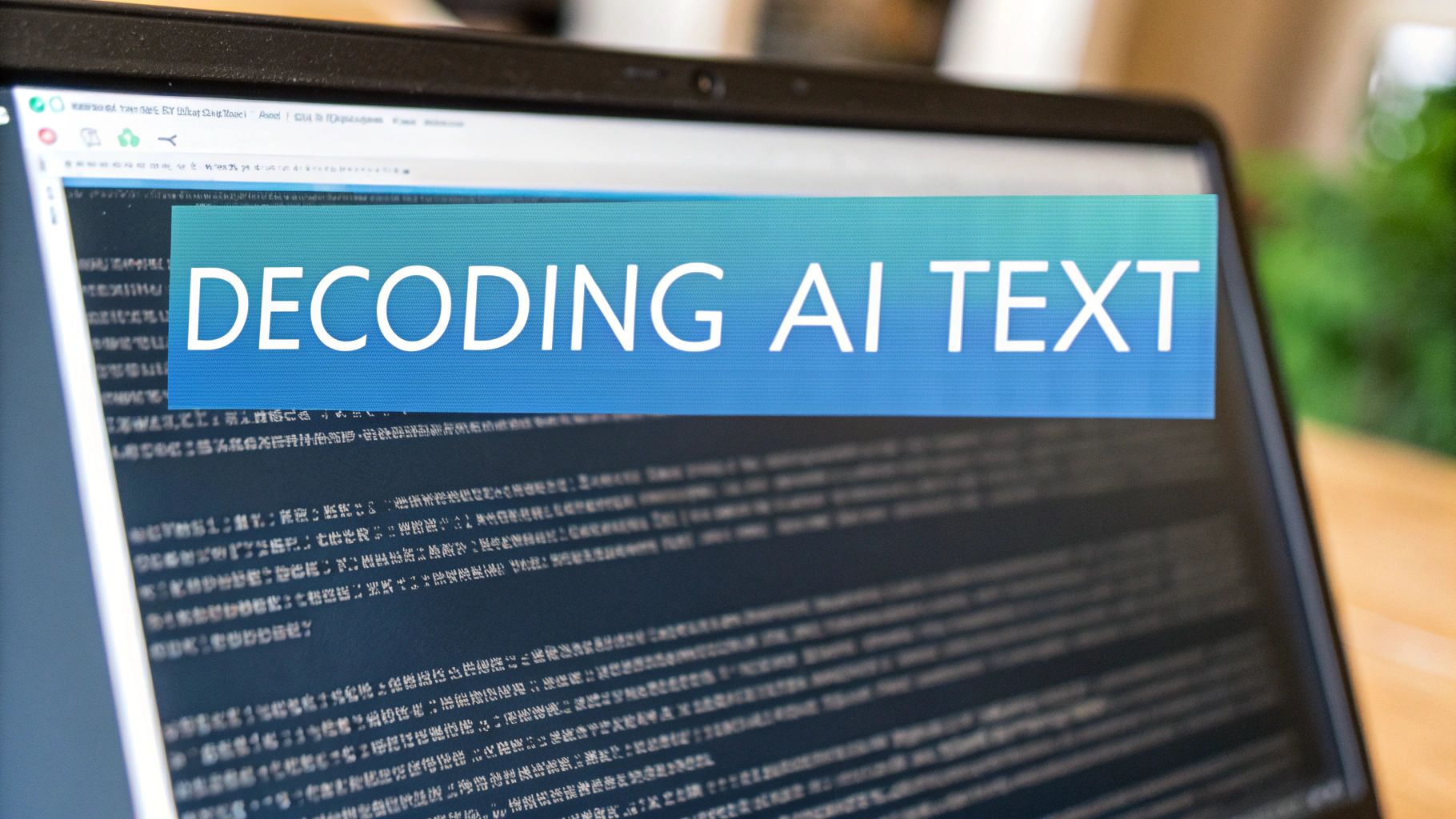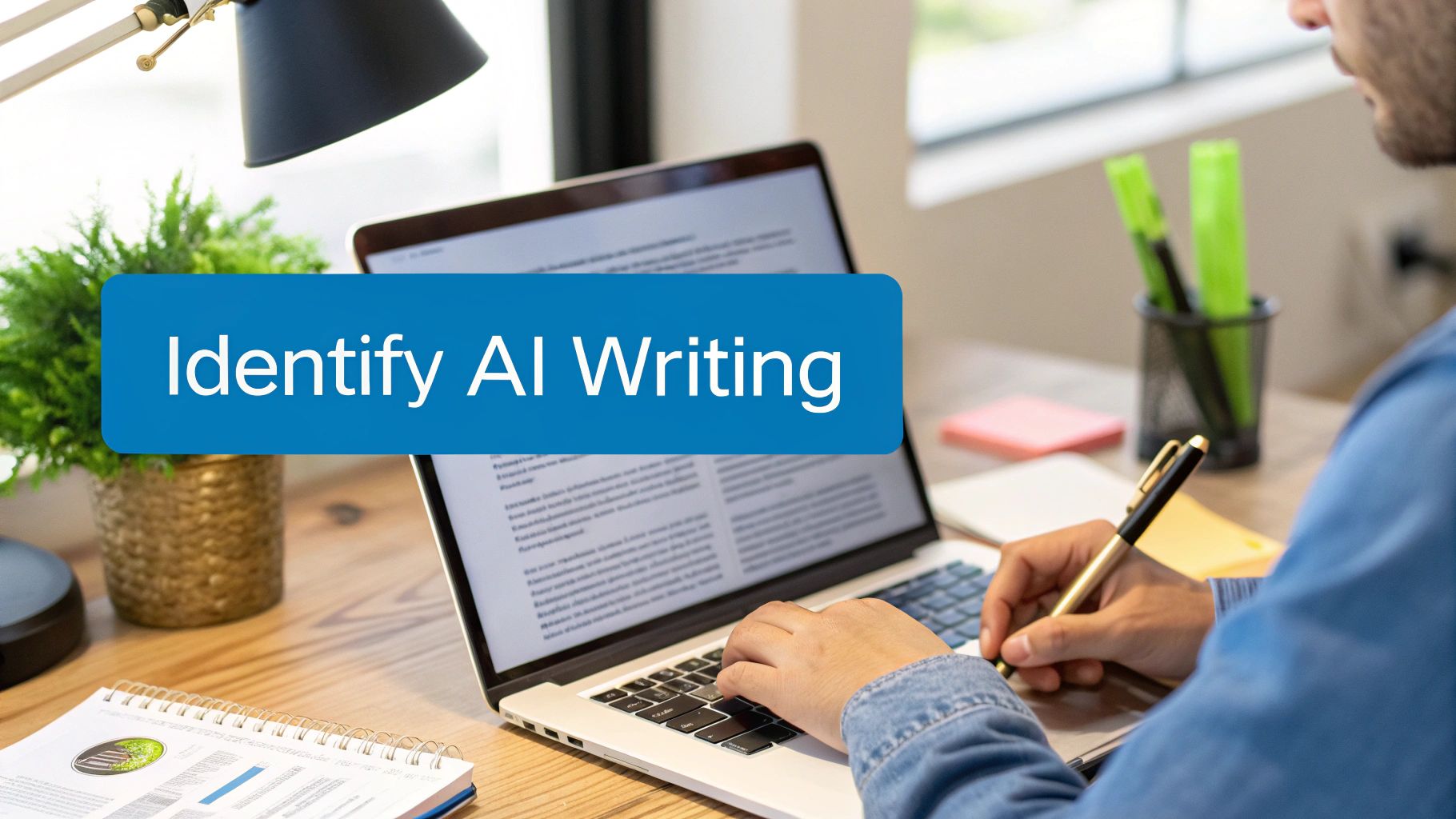Breaking Down the AI Detection Challenge

Detecting AI-written content requires more than just intuition. While many people think they can spot AI writing by "feel," accurately identifying machine-generated text demands understanding key differences between human and AI writing patterns. Let's examine the specific characteristics that help distinguish between the two.
Understanding the Tell-Tale Signs of AI
When reviewing text, certain patterns often reveal AI authorship. The most obvious sign is repetitive phrasing and predictable sentence structures. AI tends to overuse certain transitions and formal language constructions, creating text that sounds mechanical. For instance, you might notice frequent use of phrases like "furthermore" or "therefore" in ways that feel forced rather than natural. While AI can copy basic writing patterns, it struggles to capture the authentic voice and personal perspective that makes human writing unique and engaging.
The Role of Linguistic Analysis in AI Detection
Professional AI detection relies heavily on linguistic analysis tools and techniques. These tools examine specific word patterns and combinations using methods like N-gram analysis to identify statistically unusual language constructions typical of AI writing. However, this approach faces growing challenges as newer AI models become better at mimicking natural language. This evolution means we can't depend solely on automated analysis – we need multiple detection methods working together.
Contextual Inconsistencies and Factual Errors: Unveiling AI's Weaknesses
One of AI's key limitations is maintaining consistency across longer pieces of content. While AI can access large amounts of data, it often makes subtle mistakes in how it connects and presents information. These errors show up as contradictions between different parts of the text or outdated/incorrect facts that a human writer would catch. Spotting these inconsistencies requires careful reading but provides strong clues about whether AI created the content.
The Human Element: Why Expert Analysis Remains Crucial
The most reliable approach to AI detection combines automated tools with human expertise. While AI detection software can flag suspicious content, experienced editors and content specialists play an essential role in making final determinations. They can recognize subtle indicators that automated systems miss and understand context in ways machines cannot. This partnership between technology and human judgment offers the best method for identifying AI-generated writing with confidence and accuracy.
Mastering Modern Detection Tools
Today's content creators need reliable ways to identify AI-written text. Just as content creation tools have advanced rapidly, so too have the tools designed to detect machine-generated writing. Understanding how these detection tools work – and their limitations – is crucial for anyone working with online content.
Exploring Leading AI Detection Platforms
Several detection platforms stand out in the field. Originality.ai specializes in academic integrity checks with high accuracy rates. Copyleaks combines traditional plagiarism detection with AI content analysis. And GPTZero focuses specifically on identifying text from models like GPT-3. Each platform brings unique capabilities to content verification. You might be interested in: How to master content checking.
Understanding the Strengths and Weaknesses of Each Tool
While these tools share the goal of identifying AI-written content, they work in different ways with varying degrees of success. For instance, Originality.ai excels at catching paraphrased AI content but sometimes flags complex human writing as machine-generated. Copyleaks effectively spots direct plagiarism but may miss subtle AI-generated text that appears original. GPTZero specializes in detecting specific AI models but struggles with content from newer or less common tools. Understanding these limitations helps users choose the right tool for their needs.
Combining Tools for Enhanced Accuracy
Given that each platform has its own blind spots, many professionals use multiple tools together for better results. This approach helps catch what individual tools might miss. For instance, using both Originality.ai and GPTZero provides more thorough detection than either tool alone – similar to how doctors often run multiple tests to confirm a diagnosis.
Practical Applications and Real-World Results
These detection tools serve essential roles across industries. Teachers use them to check student work, content marketers verify authenticity to maintain SEO rankings, and journalists fact-check sources to fight misinformation. However, no tool is perfect – AI writing technology constantly evolves, requiring detection methods to adapt. For content professionals, this means staying informed about advances in both AI writing and detection capabilities is key to maintaining content quality and authenticity.

Building Your Detection Workflow
After exploring available AI writing detection tools, the next essential step is creating a practical workflow for using them effectively. A well-designed detection process helps maintain content quality, academic integrity, and information authenticity. This involves more than simply checking text with a detection tool – it requires a thoughtful approach based on your specific needs.
Establishing a Multi-Layered Detection System
Just as smart investors diversify their portfolios, an effective AI detection system should use multiple methods rather than relying on a single tool. This means combining automated checking with human review. For instance, you might start with a scan using Originality.ai to identify potential AI-generated sections, followed by a human editor examining those flagged passages in detail. This approach combines software efficiency with human expertise in language and context.
Developing Clear Guidelines and Protocols
Clear rules help teams work consistently and avoid confusion. Your guidelines should address key questions like:
- What amount of AI-generated content can be accepted?
- What are the consequences for submitting fully AI-written work?
- How should borderline cases be evaluated?
- Which detection tools should be used in the standard process?
Writing down these protocols helps maintain standards across different types of content and ensures everyone knows what's expected. This becomes especially important in educational settings or when handling sensitive information.
Handling High-Volume Content Checking
When reviewing large amounts of content, efficiency becomes crucial. Automating the initial detection steps can help manage the workload effectively. Tools that offer API access can be integrated with content management systems to check submissions automatically before they reach human editors. This pre-screening focuses human attention where it's needed most – on potentially problematic content.
Managing Edge Cases and Ambiguous Results
Even with good tools and clear protocols, some results will be unclear. As AI writing technology keeps improving, certain AI-generated text becomes harder to identify. For these situations, having a secondary review process helps maintain accuracy. This might involve getting a second opinion from a more experienced editor or using an additional detection tool. Looking at contextual details, like an author's writing history or the topic's complexity, can also help make better decisions. By carefully considering these challenging cases, the overall detection process becomes more reliable and fair.
Navigating Common Detection Pitfalls

Creating an effective AI detection process requires understanding and addressing key challenges that can impact accuracy. Even with advanced tools at our disposal, certain pitfalls can lead to incorrect identification of AI-written content. By recognizing these common issues early on, content reviewers can develop more reliable verification methods.
The Challenge of Mixed Content
One of the biggest hurdles in AI detection is identifying content that combines human and AI writing. When writers use AI to create initial drafts and then extensively edit them, the boundaries between human and machine input become blurred. For example, a blog post might start with AI-generated text but undergo significant human revision, making it difficult for detection tools to properly analyze. The human edits often remove the typical markers of AI writing, resulting in inconclusive detection results.
Identifying Highly Sophisticated AI Writing
As AI writing tools become more advanced, their output grows increasingly similar to human writing. Current detection methods must keep evolving to stay effective. Many newer AI models now produce text with varied writing styles and fewer repetitive patterns, making traditional detection approaches less reliable. For instance, some AI writers can now maintain consistent character voices throughout a story or adapt their tone to match specific writing genres. This evolution means that older detection techniques may miss newer AI-generated content.
Managing False Positives: When Human Writing Gets Flagged
False positives present another significant challenge, where authentic human writing is mistakenly identified as AI-generated. This issue particularly affects writers with distinctive styles. For example, academic writers using formal language patterns might trigger AI detection flags, while technical documentation with specialized terminology can also generate false alerts. These situations highlight why human judgment remains essential in the review process – experienced editors can often spot the nuanced differences between AI and human writing that automated tools might miss.
Practical Solutions and Expert Tips
To handle these challenges effectively, several practical approaches can help. Using multiple detection tools together provides better accuracy, similar to getting several expert opinions. Pay attention to how ideas connect and flow throughout the text, since AI often struggles with maintaining logical consistency in longer pieces. Watch for subtle context clues like personal anecdotes or unique insights that AI typically cannot replicate. Stay informed about new developments in both AI writing and detection capabilities, since this field changes rapidly. Regular testing and updating of detection methods helps maintain their effectiveness. With these strategies in place, content reviewers can better ensure the authenticity of their work while avoiding common detection mistakes.
Training Your AI Detection Skills
Spotting AI-written content has become essential in content evaluation. While automated tools can help, developing strong manual detection abilities is crucial for consistently identifying machine-generated text. Let's explore practical approaches to build these important skills.
Analyzing Successful and Unsuccessful Detections
Learning from both your correct and incorrect assessments is key to improving your detection accuracy. When you successfully identify AI content, take note of the specific signals that alerted you – whether unusual word patterns, mechanical transitions, or a lack of authentic voice. For instance, you might notice AI tends to overuse certain phrases or struggles to maintain logical flow between ideas.
Just as valuable are the cases where you missed AI content or incorrectly flagged human writing. Perhaps sophisticated AI fooled you with natural-sounding text, or formal academic writing triggered false suspicions. Examining these mistakes reveals your weak spots and helps refine your approach. You might be interested in: How to master better results with your content.
Trusting Your Instincts and Gathering Evidence
While detection tools provide useful input, human judgment remains vital. That initial sense that something seems "off" about a piece of writing often proves accurate. However, gut feelings need concrete backup. When text raises red flags, systematically check for common AI markers like repetitive sentence structure, oversimplified arguments, or generic phrasing lacking specific examples or nuanced views.
Staying Ahead of Evolving AI
AI writing capabilities advance rapidly, with new models and methods emerging frequently. To maintain effective detection skills, you need to understand these developments, similar to how security experts track new cyber threats. This could involve testing emerging detection tools, following AI writing research, or discussing detection techniques with other professionals. Regular learning keeps your skills current as AI grows more sophisticated.
Practical Exercises and Expert Feedback
Like any skill, AI detection improves with deliberate practice. Try analyzing various texts, participating in detection challenges, or even generating AI content to better grasp its patterns. Just as a musician develops through consistent rehearsal, regular detection practice builds pattern recognition and analytical abilities. Getting input from experienced editors and content specialists also helps identify blindspots and areas for growth. Combining hands-on practice with expert guidance leads to more reliable detection capabilities.
Preparing for Future Detection Challenges

AI writing technology continues to advance rapidly, making detection an ongoing challenge. As content creators, educators, journalists, and marketers, we need to stay ahead of these changes by understanding not just current detection methods but also preparing for future developments. Taking a forward-thinking approach is essential for anyone working with online content.
Emerging Detection Technologies
The tools for detecting AI-generated text must evolve alongside increasingly capable AI writing models. While analyzing writing patterns and linguistic markers remains useful, these methods are becoming less reliable as AI gets better at mimicking human writing styles. For instance, modern AI can now create natural variations in sentence structure and add subtle stylistic elements that previously made AI text easy to spot.
One promising new direction is developing detection systems with improved contextual understanding. Rather than just examining words and grammar, these systems aim to evaluate the overall coherence and meaning of a text, similar to how human readers can spot inconsistencies in logic and flow. This deeper analysis could help identify AI-generated content even as the technology improves.
Researchers are also exploring detection methods beyond pure text analysis. This includes examining metadata like creation time, editing patterns, and device information to create a more complete picture. By looking at multiple factors, future detection tools may provide more accurate and reliable results, even against increasingly advanced AI writing.
Adapting to More Sophisticated AI Writing
Organizations need practical strategies to keep pace with evolving AI detection challenges. A key first step is investing in detection tools that receive regular updates and incorporate new technologies. Relying on older, static tools will become increasingly ineffective. Learn more in our article about leveraging Chrome extensions for content creation.
Equally important is ongoing training and skill development. Building expertise in spotting AI-generated content, even without automated tools, requires understanding common AI writing patterns and practicing manual detection techniques. Like learning any new skill, consistent practice and exposure help develop this ability over time.
A Practical Approach to Future-Proofing
While new detection technologies show great promise, maintaining focus on proven current methods remains crucial. This means using a combination of automated tools and human expertise, implementing multi-step verification processes, and establishing clear content evaluation standards. For example, including plagiarism checks in your workflow helps catch instances where AI has copied existing text – a common issue with basic AI models.
Building strong critical thinking and media literacy skills across your organization is also essential. This includes teaching people to question content sources, assess credibility, and recognize potential manipulation. These fundamental skills become increasingly valuable as distinguishing between human and AI-written content grows more challenging.
Looking for powerful AI tools to streamline your academic work? SmartStudi offers a suite of solutions, including AI and plagiarism detectors, paraphrasing tools, essay generators, citation generators, summarizers, and grammar checkers. Boost your productivity and enhance your writing with SmartStudi today! Visit https://smartstudi.com to explore our offerings and experience the future of academic support.
